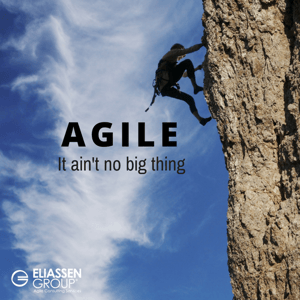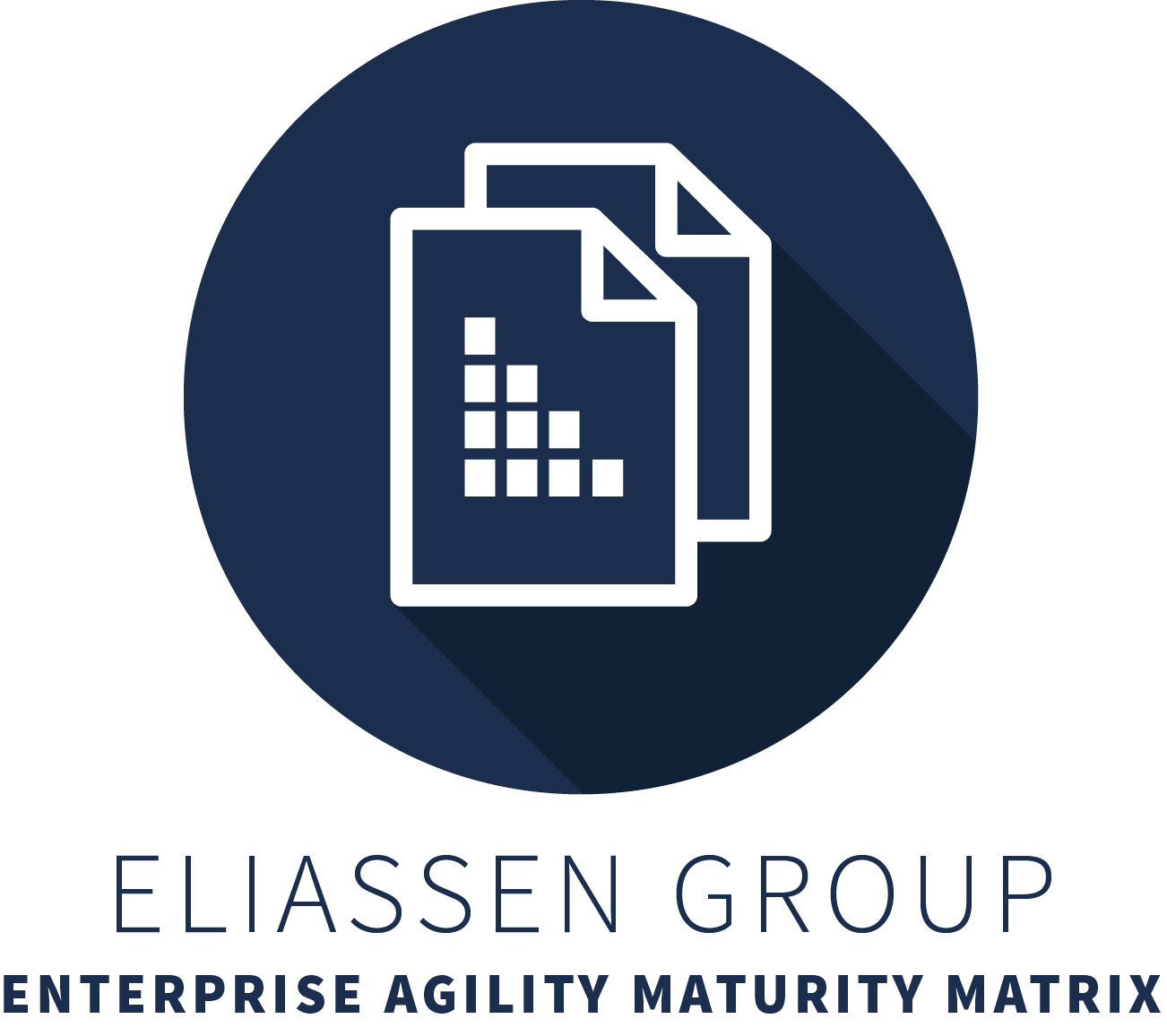Any transformation is a journey — and to complete a journey successfully, you’ll need to know where you are starting from. Stephen Gristock, Agile Delivery Lead at Eliassen Group, and Audrey Boydston, Enterprise Transformation Coach at Scaled Agile, hosted a webinar that dives deep into the details of assessment and how you can apply it to your own work.
How We Define Agile Assessment
Assessment involves setting goals and measuring yourself against them; however, Gristock admits early in the webinar that, "Sometimes there's a little bit of discomfort with the term 'assessment.'" Boydston explains that an assessment is always based on capturing how you are doing during a specific moment in time, but it doesn't have to involve filling out a formal checklist. In fact, it can be as straightforward as having coffee time with leaders to check on how a transformation is going.
Gristock notes that a checklist might not paint the clearest picture of what's going on: "You can check the boxes, and on paper it looks as though we're doing great, but the reality is that often that misses the point, and that is that we're looking for changes within the culture."
The Purpose of an Agile Assessment
Assessments can help you know where you are starting from so you can measure your progress. The basic steps of assessment include
- Taking a snapshot of where you are today
- Using that as input for your strategy or roadmap
- Continuing to apply that strategy going forward
Even though you will always be refining your strategy, assessment helps you establish an initial baseline so you can learn what is working well or what needs to change.
Scenarios for Using Agile Assessments
One of the most important factors of success for an assessment is knowing when to share it, whether the outcome is positive or negative. When an organization has made considerable progress, Boydston recommends sharing an assessment at launch: "Sometimes it's a great way to get started to say, 'Here's where we started from because then you're going to see progress, and then you're going to see over time, through our transformation, here's some of the changes." At this time, you can also share opportunities for an organization to get even better.
Assessments can also be shared when leaders do not see the growth and improvement that they expected. Boydston notes that's the time to start figuring out why that is so you can see "where we were, here we are, and what are some of the things that could be causing that assessment to give you clarity on why some of those benefits really have not been brought to fruition."
Approaches to Your Agile Assessment
An assessment is not the same thing as a grading sheet or a checklist, and Gristock says, "There isn't a one-size-fits-all approach to assessments." He then goes into the various assessment approaches based on Types, Scope, Modes, and Instruments.
Types
The two major types of assessments can help you get started. All you need to do is consider what you want to achieve. The first option is to establish a baseline that you can develop a plan from. Or, you can assess an organization to find out how it is progressing against goals that may have already been set in place.
Scope
You may further adjust your assessment depending on who is being assessed. Gristock recommends that you ask yourself the following questions: "What are we attempting to examine here? What is our sample set? Is it truly a cross-functional representation of the organization that we're attempting to assess?" You may realize that you should look at a company's org chart or start thinking about organizations that encounter your target organization as part of their work.
Modes
"Mode" answers the question of how big and how quick the assessment will be, and if the assessment is big enough that you will require outside resources. If you are setting a baseline, then the sample set may need to be bigger, you may need more discovery time, or you may need to bring in an outside consultant. On the other hand, you might want to assess yourself and take a quick snapshot of where your own organization is.
Instruments
You can choose from many tools or combinations of tools to carry out your assessment. That includes survey tools, observation, interviews, or reviews of artifacts. To collect information efficiently, Gristock recommends interview-based tools.
Frames of Reference
Frames of reference help you determine what you are measuring or comparing your organization against, which can help anyone performing an assessment stay objective. You'll also need to take outside factors, like historical data, or how you stack up against transformations in other business units into account. Boydston cautions, however, "There is not one assessment that's perfect and that is the only one that you would ever use."
Principles
While there is no one perfect assessment, an assessment should still be more flexible than an audit. At a minimum, per Gristock, an assessment should align with the following principles:
- Confidentiality
- Non-attribution (no references to individuals or sub-groups)
- Collaboration
- Objectivity
They should also be focused, supportive of improvement, pragmatic, action-oriented, and minimally invasive.
Selecting an Agile Assessment Approach
Finding the right approach for you is critical. Boydston says, "It is incumbent on change leaders that are helping support these transformations to find the assessment that's going to tell the story that you are looking for, that's going to help you understand your context, that's going to help guide you as you're looking for ways that you can help your teams to be successful."
Once you are at the point where you can select an approach, Boydston offers several ways to narrow down your options:
- Formal versus informal
- Guided versus independent
- Cross-cutting versus one area
Whatever you choose, Boydston advises, "The whole reason for this is not to blame.... Look at it solely as opportunities to continue to get better. These assessments are going to uncover what some of these opportunities are."
Typical Assessment Flow
An assessment often features three steps. The first is planning, in which you sit down and figure out the scope of the project. Gristock notes, "Trying to build a picture of the organization is critical, not just the target organization, but the world around them within their ecosystem." The next step involves discovery, which requires advance planning so you can talk to the right people and get the information you need in the time allowed. Finally, you will share your findings as a report and start to gather feedback until you generate a final version. During this phase, according to Gristock, you'll need to rely on objectivity, expertise, and a framework, and he advises sharing the final report with everyone who participated, no matter how junior.
The Agile Maturity Assessment Report
The final Agile maturity assessment report doesn't mean the end of the assessment. Boydston says, "We don't recommend doing an assessment just to do an assessment." The results should encourage meaningful actions that align with your overall roadmap so that everyone who participates in the assessment feels like they have a voice.
Conclusion: Patterns to Follow
Gristock then follows up with some of the not-so-helpful patterns that he has encountered in the past. First, you don't want to get too focused on individual details that you may have learned about the organization because a single sample may not represent the whole. Boydston also advises that you shouldn't take all your findings at face value and assume that just because someone said something is how it must be. Gristock concludes the conversation on not-so-helpful patterns by advising that leaders may see Agile transformations as transactions as opposed to an ongoing effort. The true goal is to set expectations that "those in leadership have a part to play in the journey as well."
On the other hand, success patterns revolve around how the data is treated. First, the data needs to be protected. Boydston says that the people being interviewed as part of the assessment need to know that they are in a safe space and can speak openly. Then, Gristock states that the data must be explored, which runs alongside not taking the data at face value. Boydston adds that a true success pattern is when people act upon the data found in the assessment: "There is nothing more energizing and inspiring … when people actually do something with the data to help make your lives easier."
To learn more about Stephen's perspective on assessment, visit the Scaled Agile blog to read "Measuring Agile Maturity With Assessments."



